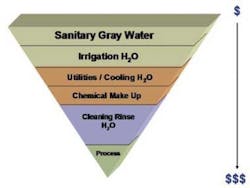Flood Proofing the UK without Disruption
Devastating flooding is becoming more commonplace globally, as has been indicated across Brisbane, Australia. To prepare against future floods, major utilities across the UK are investing into sewer rehabilitation schemes. WWi takes a look at a trenchless installation that caused minimal disturbance to local residents and businesses.
Climate change has escalated concern about flooding worldwide. In Europe, the Floods Directive was proposed in 2006 as a response to catastrophic flooding in the continent between 1998 and 2004. During this period over 100 major floods led to an insured economic loss of at least €25 billion.
The threat of flooding was witnessed first hand in the UK Midlands at the end of 2009 in the Cumbrian town of Cockermouth. The floods saw the highest ever concentration of rain in a 24 hour period. Homes, businesses and infrastructure were destroyed and lives seriously affected. One year after the event, figures suggest that £276 million worth of damage resulted from the floods.
To help prevent and limit potential damages from future floods in the Midlands, major utility United Utilities' contractor VJ Donegans Civil Engineering has embarked on an element of the Blackburn Sewer Improvement Scheme, in Lancashire. The installation comprised a DN300 gravity sewer laid to precise line and level parameters, set out by design engineers at United Utilities.
The Perforator PBA85 in the start shaft on the Blackburn flood alleviation project
A trenchless installation technique was chosen, given the urban location and need to ensure the grade of the sewer was maintained. Such a technique could also ensure the necessary line and level control. Awarded to Trenchless Solutions of Wakefield, West Yorkshire, the firm opted to use a Perforator PBA85 Guided Auger Boring system for the installation. A system with a small operational footprint was required, due to the urban location of the project, as well as having the capacity to handle expected ground conditions at the level of the pipe installation.
Adding to the auger chain during Phase 2 of the bore to upsize the pilot bore to diameter of the final pipe
Prior to the start of the installation works, cable percussive bore holes were used to undertake a ground investigation survey using a Dando 2000 drilling rig. This investigation confirmed that the ground at the installation horizon comprised soft to stiff clay.
The guided auger boring machine used included a HS56 power pack, pilot rods, as well as augers and casings designed to suit the parameters of the 1m long Naylor-manufactured Denlok DN300 clayware pipe chosen for the installation. Directional control of the pilot bore was achieved using a monitor, an optical system with a CCD camera and a diode target plate. Furthermore, a three-pass system was used with the rig for the new pipe installation, comprising an initial pilot bore. This helped established the accurate line and level of the bore, which would be followed by the subsequent installation phases. To expand the pilot bore, an auger chain with a cutting at the lead end was used.
The auger chain ran inside auger casings with excavated soil removed from the bore to the start shaft by using the rotating augers. With the bore now at the required diameter, to complete the installation the Naylor Denlok DN300 pipe was jacked into the bore, while displacing the auger chain at the reception shaft.
The PBA85 guided auger boring rig used some 850 kN (kilonewtons) of forward thrust, as well as a maximum 470 kN pullback force and operate from a start shaft or pit of a minimum 2m diameter. The machine will install pipelines from DN150 to DN500 and can be extended by up to 5m where circumstances require and are permitted to handle the installation of longer pipe section in one operation.
Work started on the 24m long sewer installation on 22 November last year with the installation completed by 24 November with no specific problems being encountered during the course of any phase of the work. The use of the trenchless system for the installation also meant that despite the urban setting local residents and businesses were not inconvenienced in any way by the presence of the works.
More Water & WasteWater International Current Issue Articles
More Water & WasteWater International Archives Issue Articles

